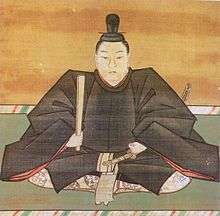Shimazu Yoshihiro

Shimazu Yoshihiro (島津 義弘, August 21, 1535 – August 30, 1619) was the second son of Shimazu Takahisa and younger brother of Shimazu Yoshihisa. Traditionally believed to be the seventeenth head of the Shimazu clan, he was a skilled general during the Sengoku period who greatly contributed to the unification of Kyūshū.
Military campaign
The defeat of the Itō clan at the battle of Kizaki on 1572 counted as one of his many victories.[1] On 1587, facing Toyotomi Hideyoshi's troops that sought to pacify Kyūshū, Yoshihiro pressed for a war even after his brother and the head of clan Yoshihisa surrendered. After Yoshihisa repeatedly asked for the surrender, Yoshihiro finally did surrender. After Yoshihisa became a Buddhist monk, it had been believed that he became the head of the clan but the real power remained in Yoshihisa's hands.
He had been a willing and a skillful general for Hideyoshi. On both 1592 and 1597 of the Seven-Year War, Yoshihiro set his foot on the Korean peninsula and successfully carried out a series of battles. On 1597, working together with Tōdō Takatora, Katō Yoshiaki and Konishi Yukinaga, Yoshihiro defeated Won Kyun's navy. At the Battle of Sacheon (泗川) in 1598, facing Ming army counting 37,000, Yoshihiro defeated them with only 7,000 soldiers. Shimazu troops under Yoshihiro were called "Oni-Shimazu (literal translation-Shimazu demons or Shimazu ogres)" by Ming. On the final battle of the war in 1598, the Battle of Noryang, Yoshihiro's objective was to cross the Noryang Strait, link up with Konishi and retreat to Japan. The Korean admiral Yi Soon Shin that had obstructed Yoshiaki died in this battle. Afterwards, Yoshihiro rescued the Japanese commanders and returned to Japan.
For the Battle of Sekigahara on 1600, Yoshihiro was supposed to take the side of Tokugawa Ieyasu, but he was crushed by Torii Mototada on arriving for a rescue at Fushimi Castle and after being humiliated, took the side of Ishida Mitsunari instead. Yet Yoshihiro could not get along with Mitsunari as well, who did not listen to any of Yoshihiro's plan including surprise night attack on the day before the actual battle. On the day of the battle, Yoshihiro and his troop of 1500 simply held ground and did not fight at all. After the rest of Mitsunari's side was wiped out, Yoshihiro was stranded in at least 30,000 of Ieyasu's troop. Vastly outnumbered, Yoshihiro tried to make a charge against Ieyasu himself but after Shimazu Toyohisa demanded that he not kill himself over a meaningless battle, Yoshihiro instead chose to charge straight through Ieyasu's troop to make an exit at the other side. By having his troop make a fighting retreat called Sutegamari (捨て奸) where until certain number of men died holding a position and repelling an attack, the main body of army fought as well. Though Toyohisa and the bulk of troop died, the charge and retreat were a success with a fatal wound dealt to Ii Naomasa in the process. After beating back the chase, he picked up his wife at Sumiyoshi of Settsu Province and returned to Satsuma Province by ships.
After recognizing why and how Yoshihiro behaved on the battle field, Ieyasu had the Shimazu clan retain its domain and let Yoshihiro's son Shimazu Tadatsune succeed him. Yoshihiro retired to Sakurajima and took up teaching younger generations. He died in 1619 and several of his retainers who had fought alongside him followed him by committing suicide.
Family
It had traditionally been believed that he became the seventeenth head of the Shimazu clan after Yoshihisa, but it is currently believed that he let Yoshihisa keep his position. Yoshihiro was essential to the Shimazu clan and both Ieyasu and Hideyoshi tried to divide the clan by treating Yoshihiro well, but treating the elder brother Yoshihisa badly, which did not succeed. He was a devoted Buddhist, and built a monument for enemy troops during the Seven-Year War.
In popular culture
See People of the Sengoku period in popular culture § Shimazu Yoshihiro
He is a playable character in Pokémon Conquest (Pokémon + Nobunaga's Ambition in Japan), with his partner Pokémon being Gurdurr and Conkeldurr.[2]
He is also a playable character in Total War: Shogun 2
He is a playable character in the Samurai Warriors series of video games.
References
- ↑ Turnbull, Stephen (2000). The Samurai Sourcebook. London: Cassell & C0. p. 221. ISBN 1854095234.
- ↑ "Yoshihiro + Gurdurr - Pokemon Conquest characters". Pokemon. Retrieved 2012-06-17.